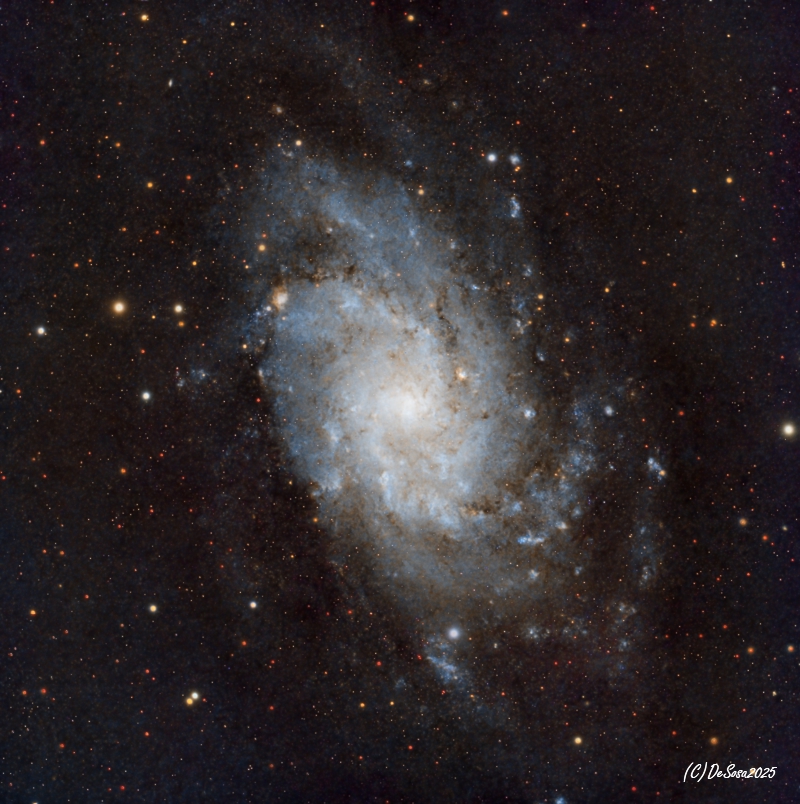The galaxy is also sometimes informally referred to as the Pinwheel Galaxy. However, the same name is used also to refer to Messier 101.
It is the third largest galaxy in the Local Group, a group of galaxies that also contains the Milky Way Galaxy and the Andromeda Galaxy, and it may be a gravitationally bound companion of the Andromeda Galaxy. The Pisces Dwarf (LGS 3), one of the small Local Group member galaxies, is possibly a satellite of Triangulum.
The Triangulum Galaxy was probably discovered by Giovanni Batista Hodierna before 1654. It was independently discovered by Charles Messier in 1764, who catalogued it as M33 on August 25. M33 was also catalogued independently by William Herschel on September 11, 1784 number H V.17. It was among the first "spiral nebulae" identified as such by Lord Rosse.
Herschel also cataloged The Triangulum Galaxy's brightest and largest H II region (diffuse emission nebula containing ionized hydrogen) as H III.150 separately from the galaxy itself, which eventually obtained NGC number 604. As seen from Earth NGC 604 is located northeast of the galaxy's central core, and is one of the largest H II regions known with a diameter of nearly 1500 light-years and a spectrum similar to the Orion Nebula. Herschel also noted 3 other smaller H II regions (NGC 588, 592 and 595).
It's estimated distance of 2.77 ± 0.13 Mly (850 ± 40 kpc) was achieved in 2004. Also the Tip of the Red Giant Branch (TRGB) method was used to derive a distance estimate of 2.59 ± 0.08 Mly (794 ± 23 kpc).
A la galaxia también se le conoce como la Galaxia del Remolino. Sin embargo, el mismo nombre también se usa para referirse a Messier 101.
Es la tercera galaxia más grande del Grupo Local, un grupo de galaxias que también incluye la Vía Láctea y la Galaxia de Andrómeda, y podría ser una compañera gravitacionalmente ligada de esta última. La Enana de Piscis (LGS 3), una de las pequeñas galaxias miembros del Grupo Local, es posiblemente un satélite de Triangulum.
La Galaxia del Triangulum fue probablemente descubierta por Giovanni Batista Hodierna antes de 1654. Fue descubierta independientemente por Charles Messier en 1764, quien la catalogó como M33 el 25 de agosto. M33 también fue catalogada independientemente por William Herschel el 11 de septiembre de 1784 con el número H V.17. Fue una de las primeras "nebulosas espirales" identificadas como tales por Lord Rosse.
Herschel también catalogó la región H II (nebulosa de emisión difusa que contiene hidrógeno ionizado), la más grande y brillante de la Galaxia del Triángulo, como H III.150, independientemente de la propia galaxia, que finalmente obtuvo el número NGC 604. Vista desde la Tierra, NGC 604 se encuentra al noreste del núcleo central de la galaxia y es una de las regiones H II más grandes conocidas, con un diámetro de casi 1500 años luz y un espectro similar al de la Nebulosa de Orión. Herschel también observó otras tres regiones H II más pequeñas (NGC 588, 592 y 595).
Su distancia estimada de 2,77 ± 0,13 millones de años luz (850 ± 40 kpc) se obtuvo en 2004. Además, se utilizó el método de la Punta de la Rama de las Gigantes Rojas (TRGB) para obtener una estimación de distancia de 2,59 ± 0,08 millones de años luz (794 ± 23 kpc).
|
|

